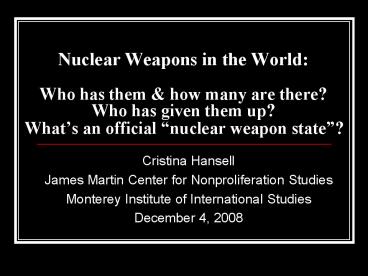Nuclear Weapons in the World: Who has them - PowerPoint PPT Presentation
1 / 16
Title:
Nuclear Weapons in the World: Who has them
Description:
Photo sources: Sen. Lugar's website; PowerPoint presentation by Jing-dong ... Photo of Titan missile (all Titans have ... Waste storage. Plutonium. Nuclear ... – PowerPoint PPT presentation
Number of Views:106
Avg rating:3.0/5.0
Title: Nuclear Weapons in the World: Who has them
1
Nuclear Weapons in the World Who has them
how many are there?Who has given them up?Whats
an official nuclear weapon state?
- Cristina Hansell
- James Martin Center for Nonproliferation Studies
- Monterey Institute of International Studies
- December 4, 2008
2
Overview
- How many nuclear weapons are there, and where are
they? - What is an official nuclear weapons state?
- What other kinds of states are there?
- What countries have sought nuclear weapons?
- What is a weapons program?
- Aside the relationship between the civilian
nuclear fuel cycle and weapons programs
Sen. Lugar and Typhoon (Russia)
Smallest U.S. Nuclear Weapon built (23.2 kg)
Photo sources Sen. Lugars website PowerPoint
presentation by Jing-dong Yuan, Feb. 7, 2008
3
How Many Weapons Are There?
- The most the world ever had
- 1986 about 70,500
- How many there are today
- about 27,000
Photo source Department of Energy website
4
Where are the nuclear weapons today?
- http//www.nti.org/db/disarmament/map.html
5
Official Nuclear-Weapon States (NWS)
- Defined in the Treaty on the Non-Proliferation of
Nuclear Weapons (NPT) - Article IX, paragraph 3, recognizes states that
detonated a nuclear device prior to January 1,
1967, as nuclear-weapon states. - All other treaty members are Non-Nuclear Weapon
States (NNWS) - Note there are 3 states that have not joined the
treaty one that says it withdrew
6
Other states with nuclear weapons
- Israel Strongly suspected of possessing nuclear
weapons. By late 1966, had completed the RD on
first nuclear weapon device BUT did not test its
nuclear devices or declare itself a nuclear
weapon state never joined NPT estimated 100-200
warheads - India peaceful nuclear test in 1974, weapons
test 1998 never joined NPT 40-50 warheads - Pakistan nuclear tests 2 weeks after India in
1998 never joined NPT 24-48 warheads - North Korea withdrew from NPT (according to
Pyongyang) tested nuclear device October 2006,
number of warheads unknown
7
Arsenals of the official Nuclear-Weapon States
- China 100-200 warheads.
- France Approximately 350 strategic warheads.
- Russia 4,978 strategic warheads, approximately
3,500 operational tactical warheads, and probably
over 11,000 stockpiled strategic and tactical
warheads. - United Kingdom Less than 200 strategic warheads.
- United States 5,968 strategic warheads, more
than 1,000 operational tactical weapons, and
approximately 3,000 reserve strategic and
tactical warheads.
Photo of Titan missile (all Titans have been
decommissioned) Source www.nuclearwinter.com/tita
n/
8
Nuclear stockpiles in NWS, 1945-2006
Includes stockpiled as well as operational
weapons. Estimates from http//thebulletin.metap
ress.com/content/c4120650912x74k7/fulltext.pdf
9
Source http//thebulletin.metapress.com/content/h
2125x87046603r5/fulltext.pdf
10
Future NWS Arsenal Plans
- December 2001 Nuclear Posture Review U.S. to
draw its nuclear forces down to 1,700-2,200
operationally deployed strategic nuclear warheads
- planned force structure for 2012 14 Trident
SSBNs (with two of the 14 in overhaul at any
time) 500 Minuteman III ICBMs, 76 B-52H bombers,
and 21 B-2 bombers. - Russia under 2,000 operationally deployed
warheads by 2012, probably about 1,500 - U.K. maintain current numbers (under 200), only
deployed on submarines - France reduce to under 300, no NW except in
operational stockpile (Sarkozy statement, 2008),
most on submarines - China maintain current numbers? (200-400?),
working on submarines
11
Some 20 countries have sought nuclear weapons
- Programs ending before NPT began Australia,
Egypt, Sweden, Canada - Factions Within Advocated for or Sought Nuclear
Weapons, but these Ambitions Ended by the Time
NPT Started Italy, Japan, Germany, Norway - Programs that Ended After 1970 Brazil, South
Korea, Switzerland, Taiwan, Yugoslavia, Romania,
and South Africa (which had weapons, and gave
them up in the early 1990s) - Programs that began after 1970, but have been
given up Iraq and Libya - Suspected of nuclear intentions (but no program
proven) Iran, Syria, Algeria - Inherited Nuclear Weapons, but Now Non-Nuclear
Weapon States Party to the NPT Belarus,
Kazakhstan and Ukraine
Source http//isis-online.org/mapproject/worldmap
.html
12
- Nuclear weapons programs that began before 1970
when the Nuclear Non-Proliferation Treaty (NPT)
came into force, succeeded, and are still ongoing
Programs that ended after 1970
Ongoing, successful programs that started after
1970
Source http//isis-online.org/mapproject/introduc
tion.html
13
What is a nuclear weapons program?
- Note A peaceful nuclear program can be the
source of fissile material for a nuclear weapon
(bomb fuel) highly enriched uranium or plutonium
14
The Nuclear Fuel Cycle
Uranium Mining
Milling (getting the uranium out of the mined
material, results in yellowcake)
Conversion (turning solid yellowcake into a gas)
Enrichment (separating U235 from U238)
Fuel fabrication for heavy water reactors (like
early CANDU reactors) that do not use enriched
uranium fuel
Conversion (turning gas back into solid)
Fuel fabrication (making reactor fuel rods)
Use in Nuclear Reactor
Spent fuel
Reprocessing
Plutonium
Waste storage
15
Nuclear Weapons Programs
- Need bomb fuel either enrichment facilities
(to acquire highly enriched uranium) or reactor
plus reprocessing plant - Need bomb design
- Need scientists engineers to build the weapon
- Need to test the device
- Need delivery systems
- peaceful nuclear programs can be misused to
help get 1 and 3
16
Recap
17
Why?
From Michael May, http//www.stanford.edu/class/m
sande193/Handouts/Autumn_2006_07/10_11_2006.pdf































